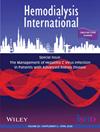Associations Between Type of Hemodialysis Access and Pulmonary Hypertension: A Single-Center Retrospective Cohort
Abstract
Background
Pulmonary hypertension affects patients with hemodialysis-dependent end-stage kidney failure; however, the estimated prevalence varies greatly due to the underutilization of right heart catheterization and the evolving diagnostic criteria of pulmonary hypertension. Pulmonary hypertension in end-stage kidney failure is often attributed to arteriovenous (AV) access; therefore, we hypothesized that patients with AV fistula/graft would have a greater prevalence of pulmonary hypertension on right heart catheterization compared to those with central venous (CV) catheter accesses.
Methods
In this retrospective single-center cohort study, we identified and randomly sampled patients from July 2012 to August 2022 receiving hemodialysis for ≥ 3 months and who underwent right heart catheterization, using Current Procedural Terminology codes. Pulmonary hypertension was defined as mean pulmonary arterial pressure (mPAP) > 20 mmHg. Our primary outcome was the prevalence of pulmonary hypertension among patients with AV fistula/graft versus CV hemodialysis access, tested with descriptive statistics. We evaluated survival as a secondary outcome using a Cox proportional hazards model.
Results
A total of 3834 patient charts were extracted. Overall, 444 charts were randomly sampled, resulting in 137 subjects meeting the inclusion criteria. The mean age was 63.8 ± 10.5 years, and 62% were male. The most common etiology of end-stage kidney failure was diabetic kidney disease (57.7%). Eighty percent of end-stage kidney failure patients had pulmonary hypertension; however, the type of hemodialysis access was not associated with pulmonary hypertension (85% CV catheter vs. 79.5% AV access, p = 0.59). Patients with pulmonary hypertension had lower hemoglobin (9.6 ± 0.8 vs. 11.2 ± 1.3 g/dL, p < 0.0001) and serum albumin (2.3 ± 0.9 vs. 3.4 ± 0.6 g/dL, p < 0.0001) than those without pulmonary hypertension. Those with pulmonary hypertension had an increased risk of mortality (hazard ratio: 2.2, 95% confidence interval: 1.04–4.61; p = 0.04).
Conclusion
Our findings show a high burden of pulmonary hypertension among this heterogeneous cohort of end-stage kidney failure patients, with no association between pulmonary hypertension and the type of hemodialysis access. This study highlights the need for prospective investigations incorporating current strategies for pulmonary hypertension diagnosis and treatment among the dialysis-dependent population.

 求助内容:
求助内容: 应助结果提醒方式:
应助结果提醒方式:


